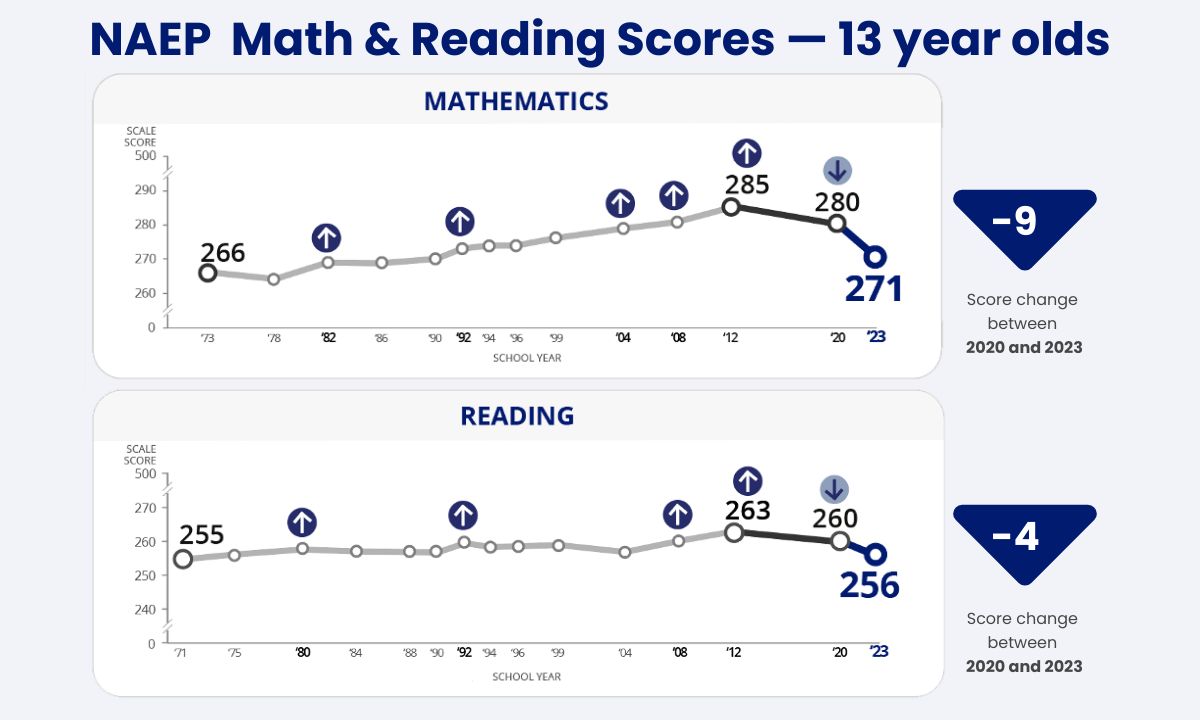Why is math growth and proficiency important?
Strong math skills are the building blocks for a successful future because they give students the ability to think critically and solve problems. Research tells us that math success is one of the important indicators of students being on track for college and career success. Based on recent national exams, only 36% of fourth-grade students are proficient in math; the numbers are even lower for eighth-grade students.
What the experts say:
The recent release of the National Assessment of Education Progress (NAEP) data delivered concerning news over the continual decline in literacy and math rates.

The National Assessment of Education Progress (NAEP) Math & Reading Scores 2020-2023 data
What do we understand about how students learn math?
Blending both procedural and conceptual understanding, along with developing problem-solving skills and a productive disposition will encourage math success at all levels. Ensuring that all types of learners have opportunities to thrive will promote engagement and build strategic competence. Students need to access multiple problem types in a variety of contexts to ensure that transfer of knowledge leading to success in subsequent math courses.
How to support math proficiency and growth?
One of the greatest challenges faced by educators is the need to engage students with grade-level content – the content that students will encounter on high-stakes tests – while also filling prerequisite content gaps. Teachers need a strategy for driving success for each student’s unique learning journey. It is critical that educators are equipped with the tools to drive grade level instruction and individual proficiency for every student.
At Renaissance, we believe that right technology drives a variety of practice and instruction to ensure an effective learning experience for every student. Our math solution helps teachers accurately assess learning, provide insight-driven learning opportunities, and connects meaningful practice to rich problem-solving activities bringing relevance to student learning.
With access to data driven instruction and practice using data from Renaissance Star, FastBridge or even other common assessments, teachers can close proficiency gaps and drive student growth. Through opportunities for individual, small-group, and whole-class activities, Renaissance’s solution allows for a student-centered, teacher-driven classroom.
The data from Star Assessments flows directly into the Freckle Math program and places students right away, so we knew we had a learning path for each one of our students.
Dr. Brad Snyder, Associate Superintendent of Educational Programs, Diocese of Orange
Math tools from Renaissance
Renaissance empowers teachers to drive success for each student’s unique learning journey. Our interconnected solution set of engaging math practice and instruction tools — combined with valid, reliable, and research-based math assessment — help teachers accelerate growth and ensure every student builds the math skills needed to succeed.
Math assessment
Star Math
Star Math pinpoints each student’s location on your state’s own learning path. Highly rated for both screening and progress monitoring, Star Math identifies skills students are ready to learn and serves as a placement into both Freckle and Nearpod, starting students on their learning pathway.
FastBridge
FastBridge identifies students’ academic and non-academic needs faster, aligning the right interventions at the right time, and measuring whether interventions are helping students catch up-all in one platform. FastBridge’s research-based assessment data serves as a placement into Freckle Adaptive Practice.
Star Math puts assessment data to work for educators
Differentiated math practice
Freckle
Covering standards and skills for K through Algebra 2, Freckle engages every learner in differentiated math practice. Freckle is personalized, easy to use, and engages students with interactive tools, immediate feedback, and timely support (in English and Spanish) to ensure practice is challenging and rewarding. Freckle connects with the data from Star Assessments and FastBridge to start students at their just-right level.
Renaissance Focus Skills
Star Math’s valid and reliable assessment data unlocks Freckle’s Focus Skills Practice, which develops critical skills through the students’ current grade level. Focus Skills are based on extensive research, and are fundamental to student understanding, involving concepts that students must master in order to advance to the next step.
Freckle student dashboard
Differentiated instruction
Nearpod
Nearpod provides differentiated instruction to improve student learning. Nearpod connects with Star Assessments to make Star data actionable in the classroom. Teachers differentiate instruction using high-quality lessons, videos, and activities tied directly to the skills and standards identified by Star data and deliver those lessons with a click of a button.
Nearpod student dashboard
Motivate students to reach their full potential
Star Math, FastBridge, Freckle, and Nearpod support a range of teaching and learning styles:
whole group, small group, math centers, enrichment blocks—even RTI/MTSS models.
We have used Freckle in combination with STAR Math assessments to help guide our intervention time. We use the data from the assessment to provide meaningful activities for each student. This allows us to individualize their work to meet any deficits or to provide enrichment activities.
Matt Metzger , Selinsgrove Area SD
Frequently asked questions:
Computational fluency refers to students’ ability to compute with accuracy, flexibility, and efficiency (Adding it Up, 2001). This ability grows and develops as students progress in the mathematics learning, particularly when students are provided opportunities to engage with appropriate practice and discuss their strategies. Computational fluency begins with operations on single digit numbers but extends to work with operations on multi-digit numbers, decimals, and rational numbers.
Computational fluency is critical because it provides access to strategies that are available to explore a given situation. Students are able to use foundational skills to solve richer, more meaningful problems thereby contributing to success in higher level mathematics.
While the Science of Math does not yet have the research foundation available for the Science of Reading, there is a need to understand the research-based practices regarding how students learn mathematics.
Students require access to grade-appropriate content which is aligned to their rostered grade. Teachers are tasked with preparing students for subsequent grades and, often, the level of preparation is measured via standardized assessments on grade level content. Therefore, students need to access grade level content but should also be bolstered with pre-requisite content support, as needed. Students who are multiple grades behind, particularly in certain domains, should work through adaptive practice to build up proficiency in content that aligns with their ability level in that domain.
The disruptions in school certainly exacerbated proficiency gaps, but the gaps have existed for quite some time. Recent studies have reviewed the range of ability levels in a typical grade and shown that the pandemic added several months (depending on the grade level) to that range. In other words, there has always been a wide range of student ability levels in a single class and that has grown just a bit over the past several years. There is still a lot of work to be done to minimize the gaps that existed before, and now after, pandemic disruptions.
While we know that all math skills are critical, there are some that are more important than others when it comes to success with future math skills. Teachers need to identify these priority standards and focus on ensuring students have mastered those skills in their current course, as well as previous courses. Ideally, the prerequisite priority standards are covered at the appropriate time during their current grade-level practice, but they can also be highlighted during extra math practice blocks to ensure students are prepared for grade-level work.
Contact us
References
Kilpatrick, J., Swafford, J., & Findell, B. (2001). Adding It Up: Helping Children Learn Mathematics. Washington, DC: National Academy Press.

